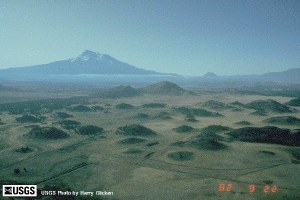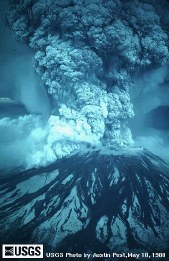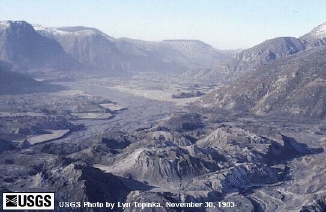Hummocky
Terrain
 Located
near Mt. Shasta in northern California are hundreds of small
hills and mounds (hummocks) whose origin had been a puzzle
to geologists for several decades. Some scientists thought
they were produced from glacial deposits, while others
believed they were created by minor eruptions in which
volcanic material broke through vents in the Earth's crust.
It was not until the eruption of Mt. St. Helens in
Washington State on May 18, 1980 that the origin of this
hummocky terrain was finally determined. Located
near Mt. Shasta in northern California are hundreds of small
hills and mounds (hummocks) whose origin had been a puzzle
to geologists for several decades. Some scientists thought
they were produced from glacial deposits, while others
believed they were created by minor eruptions in which
volcanic material broke through vents in the Earth's crust.
It was not until the eruption of Mt. St. Helens in
Washington State on May 18, 1980 that the origin of this
hummocky terrain was finally determined.
 When
Mt. St. Helens erupted, it produced a sudden, high-velocity
movement of massive amounts of rock and soil in a landslide
called a debris avalanche. Debris avalanches form when a
portion of the face of a volcano catastrophically fails and
moves rapidly downslope. Debris avalanches are composed of
wet or dry mixtures of soil, rock, and other volcanic
materials. They are the most hazardous of all volcanic
events because they destroy everything in their path. When
Mt. St. Helens erupted, it produced a sudden, high-velocity
movement of massive amounts of rock and soil in a landslide
called a debris avalanche. Debris avalanches form when a
portion of the face of a volcano catastrophically fails and
moves rapidly downslope. Debris avalanches are composed of
wet or dry mixtures of soil, rock, and other volcanic
materials. They are the most hazardous of all volcanic
events because they destroy everything in their path.
Debris avalanches contain both large,
coherent pieces of the source volcano, called blocks, as
well as finer-grained mixtures of volcanic fragments known
as the matrix. The most characteristic topographic feature
produced from a debris avalanche are irregular-shaped
hummocks which form from the accumulation of this material.
Much of the resulting hummocky terrain is located near its
volcanic source, but it can extend outward for hundreds of
kilometers (miles).
 When
the hummocky terrain located in the blast zone of the Mt.
St. Helens eruption was compared to the deposits surrounding
Mt. Shasta, it was discovered that they were similar both in
composition and structure. The knowledge derived from the
study of the Mt. St. Helens debris avalanche has helped
scientists identify the origin of similar features in such
diverse locations as the Bandai Volcano in Japan, the
Gulunggung Volcano in Indonesia, and on Molokai Island in
Hawaii. A kind of hummocky terrain has also been observed
near the Prometheus volcano on Io. Scientists are
investigating the possibility that these hummocks may have
formed as a result of processes similar to those that occur
on Earth. When
the hummocky terrain located in the blast zone of the Mt.
St. Helens eruption was compared to the deposits surrounding
Mt. Shasta, it was discovered that they were similar both in
composition and structure. The knowledge derived from the
study of the Mt. St. Helens debris avalanche has helped
scientists identify the origin of similar features in such
diverse locations as the Bandai Volcano in Japan, the
Gulunggung Volcano in Indonesia, and on Molokai Island in
Hawaii. A kind of hummocky terrain has also been observed
near the Prometheus volcano on Io. Scientists are
investigating the possibility that these hummocks may have
formed as a result of processes similar to those that occur
on Earth.
Photo Credits:
Harry Glicken, USGS (top)
Austin Post, USGS, (middle)
Lyn Topinka, USGS (bottom)
|
 Photoglossary
Photoglossary Photoglossary
Photoglossary